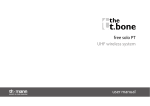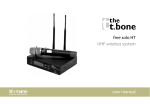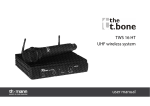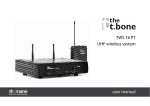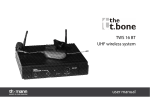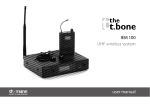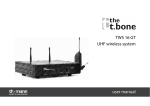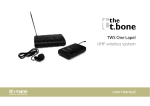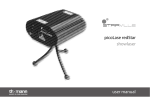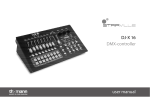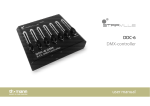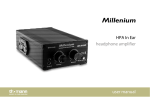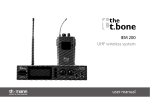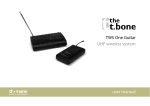Download free solo HT UHF wireless system user manual
Transcript
free solo HT UHF wireless system user manual Musikhaus Thomann e.K. Treppendorf 30 96138 Burgebrach Germany Telephone: +49 (0) 9546 9223-0 E-mail: [email protected] Internet: www.thomann.de 28.11.2013 Table of contents Table of contents 1 General notes............................................................................................................................................... 5 2 Safety instructions..................................................................................................................................... 7 3 Features....................................................................................................................................................... 11 4 Installation and starting up................................................................................................................ 4.1 General information........................................................................................................................ 4.2 Receiver............................................................................................................................................... 4.3 Transmitter......................................................................................................................................... 5 Connections and operating elements........................................................................................... 19 5.1 Receiver............................................................................................................................................... 19 5.2 Transmitter......................................................................................................................................... 27 6 Operating.................................................................................................................................................... 31 6.1 Receiver............................................................................................................................................... 31 6.2 Transmitter......................................................................................................................................... 34 7 Troubleshooting...................................................................................................................................... 39 13 13 15 18 free solo HT 3 Table of contents 8 Technical specifications....................................................................................................................... 42 8.1 Transmitter......................................................................................................................................... 42 8.2 Receiver............................................................................................................................................... 45 9 Protecting the environment.............................................................................................................. 46 UHF wireless system 4 General notes 1 General notes This user manual contains important information on safe operation of the device. Read and follow all safety notes and all instructions. Save this manual for future reference. Make sure that it is available to all persons using this device. If you sell the device, include the manual for the next owner. Our products are subject to a process of continuous development. We therefore reserve the right to make changes without notice. Symbols and signal words This section provides an overview of the symbols and signal words used in this user manual. free solo HT 5 General notes Signal word Meaning DANGER! This combination of symbol and signal word indicates an immediate dangerous situation that will result in death or serious injury if it is not avoided. NOTICE! This combination of symbol and signal word indicates a possible dangerous situation that can result in material and environmental damage if it is not avoided. Warning signs Type of danger Warning – danger zone. UHF wireless system 6 Safety instructions 2 Safety instructions Intended use This device is intended to be used for the wireless transmission of audio signals from micro‐ phones or instruments to amplifiers or active speakers. Use the device only as described in this user manual. Any other use or use under other operating conditions is considered to be improper and may result in personal injury or property damage. No liability will be assumed for damages resulting from improper use. This device may be used only by persons with sufficient physical, sensorial, and intellectual abilities and having corresponding knowledge and experience. Other persons may use this device only if they are supervised or instructed by a person who is responsible for their safety. free solo HT 7 Safety instructions Safety DANGER! Danger for children Ensure that plastic bags, packaging, etc. are disposed of properly and are not within reach of babies and young children. Choking hazard! Ensure that children do not detach any small parts (e.g. knobs or the like) from the unit. They could swallow the pieces and choke! Never let children unattended use electrical devices. NOTICE! Operating conditions This device has been designed for indoor use only. To prevent damage, never expose the device to any liquid or moisture. Avoid direct sunlight, heavy dirt, and strong vibrations. UHF wireless system 8 Safety instructions NOTICE! External power supply The device is powered by an external power supply. Before connecting the external power supply, ensure that the input voltage (AC outlet) matches the voltage rating of the device and that the AC outlet is protected by a residual cur‐ rent circuit breaker. Failure to do so could result in damage to the device and pos‐ sibly the user. Unplug the external power supply before electrical storms occur and when the device is unused for long periods of time to reduce the risk of electric shock or fire. NOTICE! Risk of fire due to incorrect polarity Incorrectly inserted batteries may destroy the device or the batteries. Ensure that proper polarity is observed when inserting batteries. free solo HT 9 Safety instructions NOTICE! Possible damage by leaking batteries Leaking batteries can cause permanent damage to the device. Take batteries out of the device if it is not going to be used for a longer period. UHF wireless system 10 Features 3 Features The UHF Wireless System is especially suited for professional audio transmission, for example at events, on rock stages and concert podiums, in theatres, musicals and discos. Your UHF Wireless System free solo HT is comprised of the following components: n 9.5" diversity receiver – Two antennas for optimum reception quality – Automatic frequency scanning – Infrared interface for the transfer of the frequency selection from the receiver to the transmitter – Very high sensitivity at very high Signal-to-Noise Ratio – Adjustable Squelch – Outputs: XLR, 1/4" phone socket – Mounting brackets for mounting in a 19" rack – Operating voltage supply: DC 12 V , a suitable power supply is included n Transmitter: battery powered handheld cardioid microphone free solo HT 11 Features The system operates with pre-programmed frequency groups and one configurable frequency group (user bank). The following table shows the available pre-programmed groups and the number of pro-programmed frequencies. One channel is available in the configurable fre‐ quency group. Model Pre-programmed fre‐ quency groups Number of available channels the t.bone free solo HT 600 MHz (item no. 296161) 14 15 the t.bone free solo HT 740 MHz (item no. 296199) 3 12 the t.bone free solo HT 823 MHz (item no. 296196) 8 8 the t.bone free solo HT 863 MHz (item no. 296197) 1 3 the t.bone free solo HT 1.8 GHz (item no. 323200) 16 12 UHF wireless system 12 Installation and starting up 4 Installation and starting up 4.1 General information Unpack and carefully check that there is no transportation damage before using the unit. Keep the equipment packaging. To fully protect the device against vibration, dust and moisture during transportation or storage use the original packaging or your own packaging material suitable for transport or storage, respectively. Establish all connections as long as the unit is switched off. Use the shortest possible highquality cables for all connections. free solo HT 13 Installation and starting up Notes on wireless transmission n This device utilizes frequencies that are not harmonized within the European Union (EU) and therefore may only be used in certain EU member states. In all European countries, the frequencies used for the transmission of audio signals are strictly regulated. Before you start, make sure the frequencies are allowed in the respective country and check whether the operation must be reported to the appropriate authority. n Make sure that transmitter and receiver are both tuned to the same channel. n Never set multiple transmitters to the same channel. n Make sure that there are no metal objects between the transmitter and receiver. n Avoid interference from other radio or in-ear systems. UHF wireless system 14 Installation and starting up 4.2 Receiver XLR connection for signal output on the receiver An XLR chassis socket serves as signal output on the receiver. Drawing and table indicate the XLR pin assignment (balanced wiring). 1 Ground, shielding 2 Positive signal (+) 3 Negative signal (–) free solo HT 15 Installation and starting up Phone plug for signal output on the receiver A 1/4" phone socket (TS) serves as signal output on the receiver. Drawing and table indicate the pin assignment of a suitable plug. Rack mounting 1 Signal 2 Ground, shielding The device is 19" rack mountable, it occupies 1 rack unit (RU). Necessary mounting material is enclosed. UHF wireless system 16 Installation and starting up Connecting the power supply NOTICE! External power supply The device is powered by an external power supply. Before connecting the external power supply, ensure that the input voltage (AC outlet) matches the voltage rating of the device and that the AC outlet is protected by a residual cur‐ rent circuit breaker. Failure to do so could result in damage to the device and pos‐ sibly the user. Unplug the external power supply before electrical storms occur and when the device is unused for long periods of time to reduce the risk of electric shock or fire. First, connect the power supply to the receiver and then plug the power adapter into the power outlet. free solo HT 17 Installation and starting up Mounting antennas Attach the supplied antennas to the rear panel of the receiver. To improve transmission quality and to adapt to the spatial conditions the antennas are rotatable and swivelling. If the space for the direct mounting of the antennas on the unit is not sufficient, for example, because of restricted space in the rack, you can use the optional coaxial cable to mount the antennas separated from the unit. For larger configurations with up to four receivers, the usage of the optional antenna distributor is appropriate. Audio connection and starting up Connect one of the audio outputs of the receiver to your mixing console or amplifier. Make sure that only one of both output is used at a time. Otherwise, malfunction may occur. 4.3 Transmitter Inserting batteries into the transmitter Unscrew the lower housing part of the handheld microphone. Insert the batteries respecting the correct polarity as indicated in the battery compartment. Close the battery compartment, refit the lower housing part and tighten the screws, then turn the transmitter on. UHF wireless system 18 Connections and operating elements 5 Connections and operating elements 5.1 Receiver Front panel free solo HT 19 Connections and operating elements 1 POWER Press the button for several seconds to turn the unit on or off. All previous settings are saved even if you turn off the power and disconnect the unit from the mains. 2 Infrared sensor. 3 [ADS] button Starts the synchronization of the settings with the transmitter. 4 Display. 5 [SET] button Opens up the menu. 6 button Increases the displayed value by one. 7 button Decreases the displayed value by one. UHF wireless system 20 Connections and operating elements 8 [AUTO] button Starts the automatic search for a free channel. 12, 13 Calibrated UHF antennas. The receiver evaluates the radio signal received by both antennas and selects the signal with the higher quality for further processing. free solo HT 21 Connections and operating elements Rear panel UHF wireless system 22 Connections and operating elements 9 DC 12-18V Socket to connect the supplied mains adapter. If you use a different power supply, observe the correct voltage, the polarity of the plug and the power consumption. 10 BALANCED OUTPUT XLR chassis connector as balanced audio signal output for direct connection to a mixer, a power amplifier or recording device. 11 UNBALANCED OUTPUT 1/4" phone socket as unbalanced audio signal output for direct connection to a mixer, a power amplifier or recording device. 12, 13 ANTENNA-B, ANTENNA-A Calibrated UHF antennas. The receiver evaluates the radio signal coming from both antennas and selects the signal with the higher quality for further processing. 14 Indication of the frequency range in which the device operates. The indication here must match the specification on the transmitter. free solo HT 23 Connections and operating elements Display UHF wireless system 24 Connections and operating elements 15 GP Indicates the selected frequency group. 16 CH Indicates the selected channel. 17 Indicates that the unit is locked to prevent unintentional operation. 18 Indicates that the unit is muted. 19 A/B Indicates which of both antennas is currently used for signal transmission. 20 SQ Displays the adjusted level of the squelch for the radio signal. A too high squelch level reduces the dynamics of the system. 21 RF Indicates the level of the received radio signal. free solo HT 25 Connections and operating elements 22 Shows the battery status of the transmitter from which the device is currently receiving a signal. 23 AUTO Indicates that the automatic search for a free channel is running. 24 IR Indicates that an IR signal is received. 25 FREQUENCY Indication of the frequency that is assigned to the set combination of frequency group and channel. 26 AF Audio level indicator. UHF wireless system 26 Connections and operating elements 5.2 Transmitter free solo HT 27 Connections and operating elements 31 Display. 32 Microphone grille to prevent damage and to reduce wind and breath noise. 33 Main switch Press the button for several seconds to turn the unit on or off. Briefly press the button to mute or unmute the micro‐ phone. 34 Bottom housing part. Unscrew to open. 35 SET button Opens up the menu. 36 SEL button Selects a menu item. 37 Indication of the frequency range in which the device operates. The indication here must match the specification on the rear panel of the receiver. 38 Battery holder for two AA cells (LR06), 1.5 V, or equivalent rechargeable batteries. 39 Infrared sensor. UHF wireless system 28 Connections and operating elements 51 FREQUENCY / GP / CH Depending on the selected menu item: n Indication of the frequency that is assigned to the set combination of fre‐ quency group and channel. n Indication of the set frequency group and the selected channel. 52 Indicates that the unit is locked to prevent unintentional operation. 53 GAIN Indicates the level of the transmitted radio signal. 54 Battery status display. Replace the batteries as soon as only one flashing cursor is left in the display. If the voltage of the batteries drops even further, the transmitter will automatically shut off. The battery status is also shown on the receiver. free solo HT 29 Connections and operating elements 55 Indicates that the transmitter is muted. This is the case when transmitter and receiver operate on different frequencies, if the receiver does not receive a usable signal or if you have muted the transmitter by briefly pressing the main switch. 56 Indicates the output power. UHF wireless system 30 Operating 6 Operating 6.1 Receiver Selecting the frequency 1. Press [SET]. ð The GP display is flashing. 2. Use the arrow keys to select the frequency group. Press [SET] to confirm the selection. ð The CH display is flashing. 3. Use the arrow keys to select a channel within the selected frequency group. If you have selected the frequency group ‘U’ , you can directly set the frequency using the arrow keys in steps of 25 kHz. First, set the value to the left of the decimal point, then press [SET] and after that set the value to the right of the decimal point. Press [SET] to confirm the selection. free solo HT 31 Operating ð The display indicates that the receiver is being calibrated to a new frequency. After a few seconds the display will return to the default state. Synchronising transmitter and receiver 1. Open the transmitter to uncover the infrared sensor. 2. Press [ADS]. The IR display is flashing. 3. Within ten seconds, hold the infrared sensor of the transmitter close to the infrared inter‐ face of the receiver. 4. The IR display stops flashing when the synchronisation is successfully completed. ð After three seconds, the display returns to the default state. UHF wireless system 32 Operating Setting the squelch 1. Press [SET] as long until the SQ area is flashing in the display. 2. Use the arrow keys to set the desired value. The current value is shown on the right side of the display. 3. Press [SET] to confirm the selection. ð After three seconds, the display returns to the default state. Automatic search for a free channel 1. Press [AUTO]. ð The AUTO display is flashing, the display shows the number of available free chan‐ nels. 2. Use the arrow keys to select one of the free channels. Press [SET] to confirm the selection. ð After three seconds, the display returns to the default state. 3. If the system does not find a free channel within five seconds, it automatically returns to the default state. free solo HT 33 Operating Turning key lock on or off 1. Press [SET] as long until the symbol appears. ð All buttons are locked except the main switch. 2. To turn the key lock off, press as long until the symbol disappears. ð The buttons have regained their original function. 6.2 Transmitter Unscrew the bottom housing part to get access to the operating buttons. UHF wireless system 34 Operating Frequency selecting If you don't want to synchronise the transmitter via the infrared interface with the receiver, you can also set the transmission frequency manually in the configurable frequency group (user bank). 1. Press [SET] repeatedly until the value in the GP field of the display is flashing. 2. Use [SEL] to select the frequency group. Press [SET] to confirm the selection. ð The digit in the CH field is flashing. 3. Use [SEL] to select a channel within the adjusted frequency group. If you have selected the frequency group ‘U’, you can directly set the frequency using [SEL]. First, set the value to the left of the decimal point, then press [SEL] and after that set the value to the right of the decimal point. Press [SET] to confirm the selection. ð After a few seconds the display will return to the default state. free solo HT 35 Operating Setting transmission gain 1. Press [SET] repeatedly until the figure in the GAIN field is flashing. 2. Use [SEL] to adjust the transmission gain in increments of 3 dB (–9 dB, –6 dB, –3 dB, 0 dB, 3 dB). Press [SET] to confirm the selection. Press the main switch to exit the menu without any changes. Setting transmitting power 1. Press [SET] repeatedly until the 2. Use [SEL] to change the transmitting power (5 mW, 10 mW, 20 mW). symbol is flashing in the display. Press [SET] to confirm the selection. Press the main switch to exit the menu without any changes. UHF wireless system 36 Operating Frequency group and channel display 1. Press [SEL]. ð The display indicates the used frequency group und the used channel. 2. Press [SEL] or wait for five seconds to return to the default condition. Turning key lock on Press [SEL] as long until the symbol appears. ð All buttons are locked, except the main switch. free solo HT 37 Operating Turning key lock off 1. To turn the key lock off press [SEL] and then [SET]. ð The symbol is flashing. 2. Press [SEL] again and then [SET]. 3. Press [SEL] a third time and then [SET]. ð The symbol disappears. The buttons have regained their original function. UHF wireless system 38 Troubleshooting 7 Troubleshooting In the following we list a few common problems that may occur during operation. We give you some suggestions for easy troubleshooting: free solo HT 39 Troubleshooting Symptom Remedy No sound 1. Check the power supply of the transmitter and receiver. 2. Make sure that both transmitter and receiver operate in the same frequency range. The frequency range is stated on the devices. 3. Are both transmitter and receiver set to the same channel? 4. Check the connection between the receiver and the connected audio device (amp, mixer). Is the connected audio device switched on and does the signal level on the output of the receiver match the input sensitivity of the audio device? 5. Try to improve the transmission by moving the transmitter closer to the receiver. 6. Make sure that no metal objects near the transmitter or receiver obstruct the transmission. Transmission is disturbed 1. Modify the orientation of the antennas. 2. If you use more than one wireless system at the same time, check the used frequencies and channels. 3. Interference can also be caused by other radio or in-ear systems. UHF wireless system 40 Troubleshooting If the procedures recommended above do not succeed, please contact our Service Center. You can find the contact information at www.thomann.de. free solo HT 41 Technical specifications 8 Technical specifications 8.1 Transmitter Carrier frequency UHF band (600 MHz…1.8 GHz) Frequency band the t.bone free solo HT 600 MHz (item no. 296161): 596 MHz…620 MHz the t.bone free solo HT 740 MHz (item no. 296199): 740 MHz…752 MHz the t.bone free solo HT 823 MHz (item no. 296196): 823 MHz…832 MHz the t.bone free solo HT 863 MHz (item no. 296197): 863 MHz…865 MHz the t.bone free solo HT 1.8 GHz (item no. 323200): 1,7815 GHz…1,7955 GHz Bandwidth the t.bone free solo HT 600 MHz (Artikelnr. 296161): 24 MHz the t.bone free solo HT 740 MHz (Artikelnr. 296199): 12 MHz the t.bone free solo HT 823 MHz (Artikelnr. 296196): 9 MHz the t.bone free solo HT 863 MHz (Artikelnr. 296197): 3 MHz UHF wireless system 42 Technical specifications the t.bone free solo HT 1.8 GHz (item no. 323200): 140 MHz Number of channels the t.bone free solo HT 600 MHz (Artikelnr. 296161): 211 the t.bone free solo HT 740 MHz (Artikelnr. 296199): 37 the t.bone free solo HT 823 MHz (Artikelnr. 296196): 65 the t.bone free solo HT 863 MHz (Artikelnr. 296197): 4 the t.bone free solo HT 1.8 GHz (item no. 323200): 192 Switching bandwidth 25 kHz Modulation type Frequency modulation (FM) Maximum transmission power the t.bone free solo HT 600 MHz (item no. 296161): 20 mW the t.bone free solo HT 740 MHz (item no. 296199): 20 mW the t.bone free solo HT 823 MHz (item no. 296196): 20 mW the t.bone free solo HT 863 MHz (item no. 296197): 10 mW the t.bone free solo HT 1.8 GHz (item no. 323200): 20 mW Spurious response rejection > 55 dBc free solo HT 43 Technical specifications Peak deviation ± 55 kHz NF frequency response 60 Hz…18 kHz THD < 0.5 % Signal-to-noise ratio > 102 dB (A) Operating supply voltage 2 × AA cells (LR06, 1.5 V) or equivalent rechargeable batteries Battery life span > 8 h (with alkaline cells) Dimensions (L × D) 246 mm × 53 mm Weight 250 g UHF wireless system 44 Technical specifications 8.2 Receiver Outputs XLR chassis plug, balanced 1/4" phone socket, unbalanced Sensitivity –102 dBm NF frequency response 50 Hz…15 kHz (±3 dB) THD < 0.8 % Signal-to-noise ratio > 105 dB (A) Operating supply voltage DC 12 V Dimensions (W × D × H, without antennas) 212 mm × 160 mm × 44 mm Weight 900 g Carrier frequency, frequency band, number of channels, bandwidth, switching bandwidth and modulation type of receiver and transmitter are identical. free solo HT 45 Protecting the environment 9 Protecting the environment Disposal of the packaging mate‐ rial For the transport and protective packaging, environmentally friendly materials have been chosen that can be supplied to normal recycling. Ensure that plastic bags, packaging, etc. are properly disposed of. Do not just dispose these materials with your normal household waste, but make sure that they are fed to a recovery. Please follow the notes and markings on the packaging. Disposal of batteries Batteries must not be disposed of as domestic waste or thrown into fire. Dispose of the bat‐ teries according to national or local regulations regarding hazardous waste. To protect the environment, dispose of empty batteries at your retail store or at appropriate collection sites. UHF wireless system 46 Protecting the environment Disposal of your old device This product is subject to the European Waste Electrical and Electronic Equipment Directive (WEEE). Do not dispose with your normal household waste. Dispose this device through an approved waste disposal firm or through your local waste facility. When discarding the device, comply with the rules and regulations that apply in your country. If in doubt, consult your local waste disposal facility. free solo HT 47 Notes UHF wireless system 48 Notes free solo HT 49 Notes UHF wireless system 50 Musikhaus Thomann e.K. · Treppendorf 30 · 96138 Burgebrach · Germany · www.thomann.de




















































